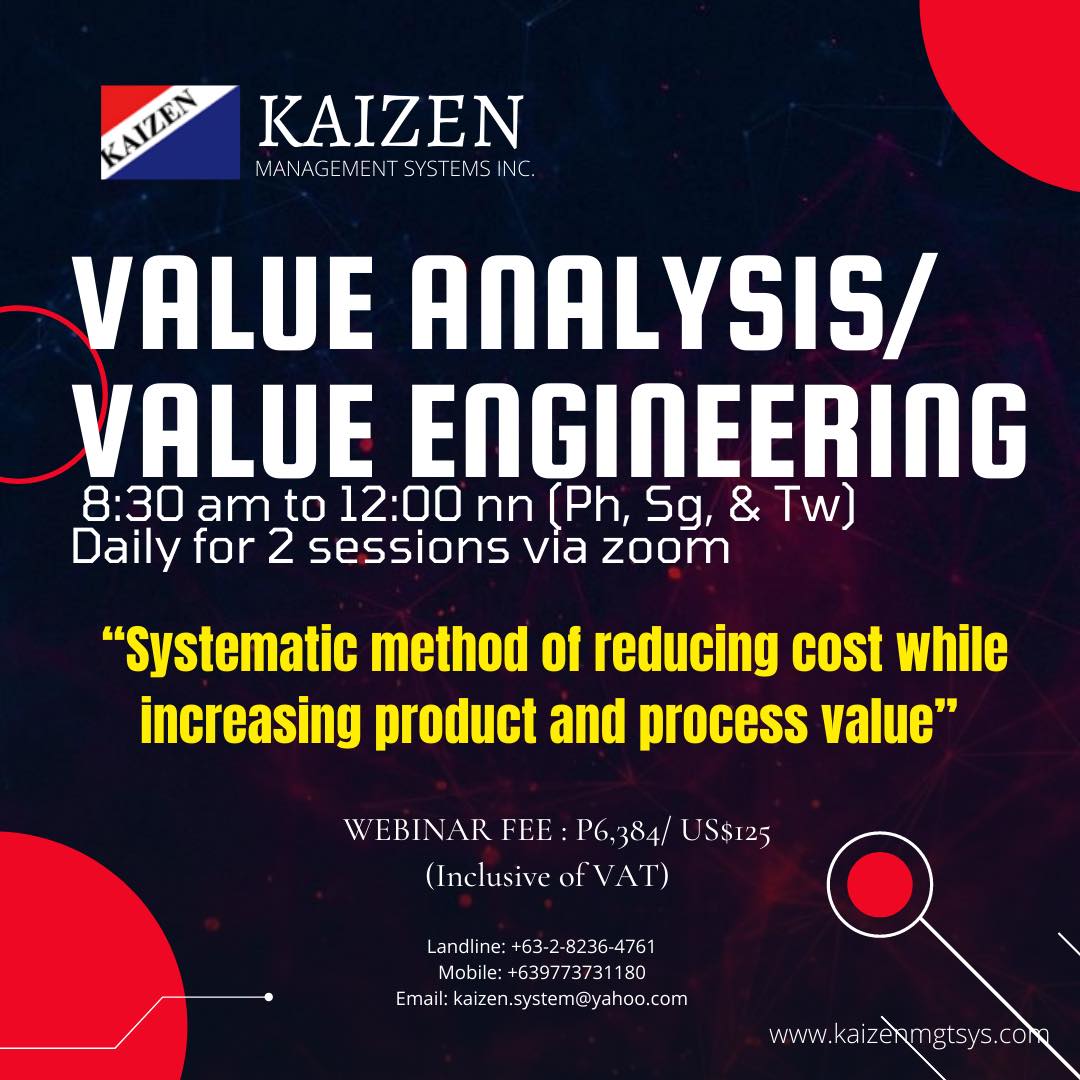By Jose S. Villegas
If we will be committing time, efforts, and resources to a problem-solving endeavor, would we not make sure that we are pursuing the right problem? Is there a way to know that the problem we are addressing is correct? Is there a systematic approach to make a clear problem statement?
Man is a problem-solving animal. Our brain is wired to detect abnormalities, inconsistencies, and problems. Living in a problem-free world would be unimaginable for us who were created (or for that matter, evolved) to solve problems. If a blank sheet of white paper with a dot on the middle is shown to a person, he or she will tend to see the tiny dot more than the all the rest of the white surface. Our eyes have been taught to focus on the fault or problem. From the discovery of how to make fire to the recent advancements in material science, our civilization has been an accumulation of continuous successes in problem solving. Every time a problem is solved, new and more difficult but exciting problems usher in. There seems to be no end to the cycle of problem recognition and search for solutions.
Problems are what make us get up early and go to work. If we don’t show up in our workplace, something unfavorable happens. Even if we are there, problems still happen. But we prefer to be there when problems occur so we can take action. To solve problems is the very reason why we were hired in the first place. Had there been no problems, we wouldn’t be in that job. Even our educational system was designed to prepare us to become problem solvers. Our society loves champions and heroes who win over difficult problems. The harder the problem solved, the greater will be the recognition and rewards. The fact is, pay scales are related to one’s problem-solving value to the company.
However, we hate problems. We want our work, projects and activities to go smooth sailing and we don’t like unpleasant surprises, abnormalities, or anything unexpected or inconvenient. We want everyone, everything, and every event to cooperate with what we want to see happen and done. We hate the very thing that makes life exciting, that for which we get paid, and what we’ve been prepared for since our beginnings.
A Problem Is a Condition
But what is a problem? Abnormality, deviation, trouble or difficulty is what people say problem is. The definition of a problem has been a subject of debates in the academe and industry. Some say a problem is a question, others say it is a statement. Subordinates say the boss is the problem while bosses say it’s the subordinates. Some believe it is the “how to”, for others it’s the “what is”. For some, a problem is a threat, while for others, an opportunity. Whatever our definition is, everyone knows that problems are there to be solved. And it seems that though definitions differ, people still manage to get over them anyway. Those who didn’t, simply faded away. Problem solving is everybody’s business. It is the business of life itself. As a Filipino saying goes: “Only the dead don’t have problems.” So problems are not the reason for living, they are part of life itself.
How do we know the existence of a problem situation? You probably have heard someone said “I know that there’s problem here but I don’t know exactly what it is.” A problem exists if one’s reality doesn’t measure up to his expectation, and if there is at least one person interested in seeing it solved.
In our experience as a consulting company, we have come across various problems. Either they are our problems or somebody else’s (our clients’). We believe that the correct understanding of the word “problem” is the key in efficient problem solving. So how do we define a problem? A problem is an unfavorable condition. It is a condition of result vis-a-vis our expectations. When we set out to do something, we want to see the progress or end result happen according to our expectation or target. So a problem is also what we failed to accomplish despite our efforts.
It is natural for people to describe problems as a condition like “bad sales”, “too many defectives”, “slow service”, “wet raw materials”, etc. The obvious issue on these kinds of statements is that there is no quantification. That is, we do not have the vaguest idea as to how bad is “bad”, how high is “too much”, how slow is “slow”, and how much water is “wet”. And of course, it doesn’t say anything about the location of the problem. Our usual human way of describing a problem can be a good starting point in making a correct problem statement. So if a guy says his problem is “bad sales”, ask how bad is his sales. Then he might answer that his target is P15,000,000 but he only did P13,500,000. “P15.0M” or “P13.5M” do not seem to indicate a “bad” condition but a “P1,500,000 shortfall” does.
Problem as a Deviation
The difference between what we actually got and what we expect is what we call a problem. So a problem can be said to be adeviation from expectation. In order to illustrate, let us take the case of a guy who was tasked to keep a net daily inventory of not more than 100,000 units in his warehouse. His average daily net inventory is 120,000 units. The expectation here is 100,000 units net daily inventory while the deviation is 20,000 units (i.e., 120,000 less 100,000). So his problem is: he has an excess inventory of 20,000 units.
A problem is a measure of unfavorable deviation in the expected result or effect. Realities and expectations must have measures in order to recognize the existence of a deviation. However, a deviation is pointless if the expectation is not well defined. It is now clear that we cannot recognize a deviation unless we have a basis. And that basis can be a target, a standard, or an expectation. The trouble is (I almost said, “The problem is…”) that targets, standards, and expectations are not fixed, which means we can change them. For instance, by lowering our expectation, we can reduce the deviation or even eliminate it. Do we say here that we can solve problems by changing the expectations? Yes, because later on, I will say that a solution is intended to eliminate the deviation or narrow down the gap.
This requires us to have a decision as to what the expectation really is. It will be ideal if the measure of expectation is well understood and quantitative. When one says “half of our production are defective”, we understand that 50% defectives is too much. But 50% is not necessarily the deviation. If the guy is not expecting a perfect condition, like, he may allow certain defectives but not more than 5%, then his deviation is 45% (i.e., 50-5). In other words, his problem is not all of the 50% defectives; it is the “45 percentage points difference above his expected 5% defectives rate.”
Deviations refer to the difference between actual and expected effects or end results and their indicators. In the sales example given above, the deviation can be stated as P1,500,000 shortfall in sales. Expectation can be a standard, target, or what is supposed to be a normal condition or behavior of processes, things, animals, and people as you want them to be. In business, expectations are usually effects, end results, or their indicators. To define the structure of deviation, consider these formulae,
Number is the numerical value or quantity of the deviation, the difference between the expectation and the reality. In most cases, (and our hope is) that it quantifies the deviation. The number may include count, percent, units (of time, distance, weight, heat, etc.) The Modifier, which can be a Noun or an Adjective or a Preposition + Noun, describes or modifies the condition of the Effect. (Nouns like shortage, deficit, gap, difference, discrepancy, or deficiency; surplus, overage, excess, etc.; Adjectives like lower, shorter, higher, taller, lighter, heavier, colder, hotter, etc.; and Preposition + Nouns like “below target”, “above tolerance”, etc.) describe the condition of the deviation. The effect describes what the deviation is. Is the deviation about market share, sales, or utilization ratio, or customer complaints, or net profit, or unit product cost, or overhead cost, or absenteeism, etc.? These effects, results or indicators interest business people and managers and will certainly be important subjects of concern.
Even at the grass roots level of business, there are effects, results, or indicators that people expect or hope to have no unfavorable deviations. A process will have expectations that depend on the 6M (men, machines, materials, methods, measurements, and Mother Nature or environment). The expectations can be in terms of correct temperature, pressure, flow rate, cycle time, yield, process efficiency, production rate, defectives rate, downtime, diameter, tolerance, temperature, pressure, etc. Unfavorable deviations from these expectations are problems. Indeed, we need to state deviations in terms of the results that we want to see which really a condition of the result or effect is. Going back to the inventory example above the deviation maybe stated as “20,000 units excess in daily average inventory”.
Not all deviations are quantifiable though, such as “I expect that there are trees where I am running but there is none”. The count of trees doesn’t seem to be the point in this expectation, so it is not practical to state it that way. How about a statement like “since my friend is handsome, I expect his wife to be beautiful, but she is ugly”. And here is another one: Asked about the color of the room, the interior designer told his painter “beige”. When the painting job was done, the interior designer said, “I don’t like this beige”. Twice it was repainted before it suited his taste. And how about this: The customer complained that he didn’t like the taste of his food. These examples show gaps between realities and expectations which are either not quantitative or not practical to quantify. And since gaps exist, then there must be problems. The following are examples of deviation and how they are structured:
| # |
Condition |
Effect or Result | Deviation | |
| Number | Modifier | |||
| 1 | 25% | Below target | sales | 25% below target sales |
| 2 | 45 grams | Higher | Average weight | 45 grams higher average weight |
| 3 | 12 minutes | longer | Service time | 12 minutes longer service time |
| 4 | 0.618% | above tolerance | width | 0.618% above width tolerance |
| 5 | pain | Pain* | ||
*non-quantifiable deviation
The Location and Time Dimensions of a Problem
Deviation alone is not sufficient to describe a problem. In order to completely state a problem, we need to identify its location and time dimensions. Problem is not everywhere and not all the time. When there’s a problem, oftentimes it does not involve the whole business but only a part of it. And it is not the whole plant or process or organization but a segment of it. It must also be noted, that the problem is not the whole situation. Not all products in a 1.6% defectives rate are part of the problem. The remaining 98.4% (100.0 – 1.6) are not part of the problem. We need to specify which part is the problem and which part is not. By doing so, we are able to identify the actual “location” of the problem. (Plant A or the Laboratory), or function/organization segment (Sales or Maintenance Department), or process/ machine (Wire Bond Machine #8), or product (Part #11235).
Time, on the other hand, describes the timing of the problem. The problem can be happening only in a segment within eternity. Did the problem happen in the past? Did the problem started sometime in the past and still happening now? Is there seasonality like “every rainy season” a drop in sales occurs”? Is there a parallel occurrence? Like during the term of a certain president when our interest rate was as much as four times that of LIBOR. Is the problem going to happen in some future time?
The deviation, location, and timing are unique characteristics of the problem. That is the place and time in which the deviation is occurring. Any changes in these dimensions change the identity of the problem. For example, a 25% shortfall in sales in Cavite is a deviation taking place only in the said location. The same deviation may not be true in Metro Manila.
Problem Statement
After recognizing the deviation, the next most important step in the problem solving process is making the problem statement. Having a correct problem statement, the problem is said to be 50% solved. But how do make a correct problem statement? A problem statement must indicate all the three dimensions of the problem namely: deviation, location and time. The location specifies where the deviation is occurring. And time, a very interesting dimension, specifies the duration and location of the problem in the time line. The formula for problem statement is
Problem Statement = Deviation + Location + Time.
Referring to the inventory case discussed above, if the manager learned that the deviation, i.e. the average excess inventory started only two months ago, then our problem statement would be: “20,000 units excess average daily inventory at the warehouse since two months ago.” Deviation is 20,000 units excess average daily inventory, location is: warehouseand time is: since two months ago.
Suppose the guy made some more investigation and came up with the following inventory details:
|
Average Inventory |
|||
|
Product |
Actual | Tolerable | Excess |
|
A |
43,000 | 25,000 | 18,000 |
|
B |
30,000 | 25,000 | 5,000 |
|
C |
25,000 | 25,000 | 0 |
|
D |
22,000 | 25,000 | – 3,000 |
|
Total |
120,000 | 100,000 | 20,000 |
Now it is clear that the problem is not all the products. In fact, deviations exist only in products A, B and D. Besides he doesn’t consider a negative deviation to be a problem either. He recognized that his problem is not all his products but only products A & B. And he has this problem not since he got the job but only since two months ago. The problem statement would be “18,000 units average excess inventory in product A and 5,000 units average excess inventory in product B in 2 months.” Which problem is wiser to address: “total inventory” or “inventory of Products A & B”? Obviously the latter is the wiser choice.
How you can use the “Problem Statement = Deviation + Location + Time” formula requires some skill and some experience. Here are examples of correct problem statements:
| # | Deviation | Location | Timing |
| 1 | 25% deficit in sales | of Product C | Since January 2006 |
| 2 | 25% deficit in sales | of Product C in Cavite | Since January 2006 |
| 3 | 30% Longer Cycle Time | at Assembly Line 1 | In April |
| 4 | Over heated | car radiator | yesterday during bumper to bumper traffic |
| 5 | Ave. of 9 min. delay | in flights departures | last year |
|
6 |
Aching (or pain)* | head | now** |
|
Headache*
|
|||
*Non-quantifiable deviation.
**If the time or timing is not mentioned, it means the deviation is happening now
Common Mistakes in Problem Statements
Statements that begin with “Lack of”, “To”, and “How to” and those that are in the question form are not problem statements. A “Lack of” statement specifies the cause of a problem. A “lack of” statement can be counterproductive because being cause-biased, the problem solver can be blinded to other real causes. Cause is not supposed to be mentioned in a problem statement because it is precisely what we are after in problem solving. However if “Lack of” is meant to say insufficient (like lack of revenue) then it must be quantified because it actually is a deviation. In one brainstorming meeting, participants were asked to identify company problems. One employee suggested that she feels the problem is “Lack of management support”. It is a genuine concern, but what end condition does it lead to? Perhaps “Lack of management support” is the main driver of problem like “20% below revenue target” last quarter.
A “To” statement is a statement of objective. I heard someone said “my problem is to improve machine availability to 90%”. Further discussions, I realized that the guy believed that improving his machine availability to 90% will help improve production rate and thus wipe out delivery delays. But what problem was he solving? Obviously, it was delivery delay. What makes his problem statement “less than ideal” when it appears that it is directed at problem resolution anyway? What makes a “to statement” wrong is its bias on achieving a goal. It sees the problem not as a “condition” but a goal to achieve. Words are powerful; the problem solver will have the tendency to pursue a goal instead of finding root causes. He will be predisposed to focus on improving machine availability because if he does, the problem (in his mind) will be addressed. The trouble is that the problem solver is blinded on other possible causes and solutions. Supposed that the” machine availability objective” is restated instead as “delivery delay” (such as “65% of deliveries last month are late”). Then this becomes a condition, and being such, he can find root causes and solutions. He may look at cycle time and find that he can make it faster. Or he can improve product/process quality if there are too many rejects. Of course he may reduce machine downtime if it is severe and frequent. All these are possible causes and solutions for a problem called “delivery delay”.
A “How to” statement seeks the best approach to accomplish a task or a course of action. In his mind, the problem solver already knows what will solve the problem. That being the case, there is no need to go through the problem solving process (finding the root causes and determine what will eliminate them). Below are examples of wrong problem statements and their corrected versions:
|
Wrong Problem Statement |
Correct Problem Statement |
| Lack of funding. | P100,000 short in funding |
| P100,000 average overdraft in checking account # 235813 last month. | |
| To eliminate raw material scraps | 5 % excess scraps in Class A Tinplates since April 2006. (Assumption is that scrap can’t be zero) |
| How to reduce the average service cycle time to 30 minutes? | 15 minutes longer average service cycle time in After Sales transaction in 2005 |
| Save on office electricity consumption by putting off the lights during lunch breaks | 55 kw-hours excess in monthly electricity consumption in the office in March 2006 |
Problems Have Owners
A problem will always have someone interested to see it solved. If there is a problem that interests no one and that nobody wants it solved, then that is not a problem. To qualify as a problem, the thing must be interesting. Problem owners are those who will benefit when the problem is solved. Benefits can be in terms of “getting better”, pain/burden removal, improvement, material gain, positional gain, avoidance of loss, and others. Sometimes the problem owner may not be the beneficiary himself but one who is interested to see that others benefit.
The Problem Solving Process
The problem solving process involves stating the problem, determining root causes, finding solutions, implementing and standardizing the solutions. Solutions are supposed to be actions that bridge the gap that the deviation makes. Solutions can be an improvement, correction or addition to the current process, in which case they will be amendments to the current operating standards. Or they can be entirely new ways of doing things that can totally replace the current process.
Arriving at a Solution
A solution is an idea, a plan or a set of measures to address a problem. The deviation, as mentioned earlier, is the indication that a problem exists. It is a good thing to know that problems have causes. At least deviations don’t just happen without a reason. The most practical way of hunting down root causes is by asking “why” until one hits bottom. That is, when a root cause is identified. Usually, a problem is caused, not by one, but a number of root causes. It is the root cause or the root causes that we attack with the end view of eliminating, minimizing, or immobilizing them in order to solve the problem. A problem is said to be solved if the deviation is wiped out or minimized as a result of implementing solutions or countermeasures. A solution can be one time action or a set of new instructions that is integrated into the routine. For example, in a certain factory, an operator frequently hammers the bin causing dents on its cylindrical tank and neck. The operator does it because the powdery raw material forms into lumps depriving the gravity feeder of the much needed material. During the problem solving process, it was found that excessive moisture content causes the formation of the lumps. So they stated the problem as “high moisture content of the raw material” (the problem can also be stated as “lumps in raw material” which is rather less quantitative). The problem solving team found that the root cause was “too much” water addition in the upstream process. And the counter-measure was to control the water addition in the upstream process to the level that % moisture at the bin will not be enough to form lumps. The outcome of the problem solving process was: a new set of operational standards was installed that measured the moisture content of incoming raw materials to the flow rate of water introduction. With new standards (solution) in-place, the operator does not hammer the bin as much as before.
Systematic Failure
In searching for solutions, sometimes we can get lucky and find the answers at once. But often times, we have to “sweat for solutions” and resort to “trial and error” which is how most solutions are arrived at. (And sometimes you may have to go back to root cause analysis even when you are already implementing your solution.) In the words of the great inventor Thomas Edison “I didn’t fail, I only learned of ten thousand things that won’t work. And as I fail I know that I am getting closer to the solution”. Of course he was referring to his search for the right material for incandescent bulb filament. I can imagine Edison testing a material that glows when electrified but quickly melted down. Then he searched for a material that glows but doesn’t melt that easily. Then he searched for a material that gives a brighter glow but doesn’t melt at all.
Indeed, failure is part of success but only if we know how to fail systematically, i.e. when every failure is a step towards the truth. Your skill in stating a problem correctly will guide you in recognizing solutions. And your skill in determining deviations will lead you to the direction of the solution.
Problems Are Opportunities
Problems can either be intended to correct existing conditions, like not being able to meet a sales target; or improve an already satisfactory condition, like when one realized that she can look even better than she does. Both situations are conditions for opportunity. Kaizen believes that problems are opportunities. Since a problem is an opportunity, there should be an anticipation of a condition that presents a chance for improvement. Having a prior awareness of what we are supposed to watch for, when we see a problem we know that this is ”it”. The truth is “we should be on the look out for problems all the time,” which is another way of saying “let us welcome problems”. Problems can be viewed as “system imperfections”. The more problems we discover and solve, the better our system becomes. And the better our business system is, the better will be our ability to control our destiny.







